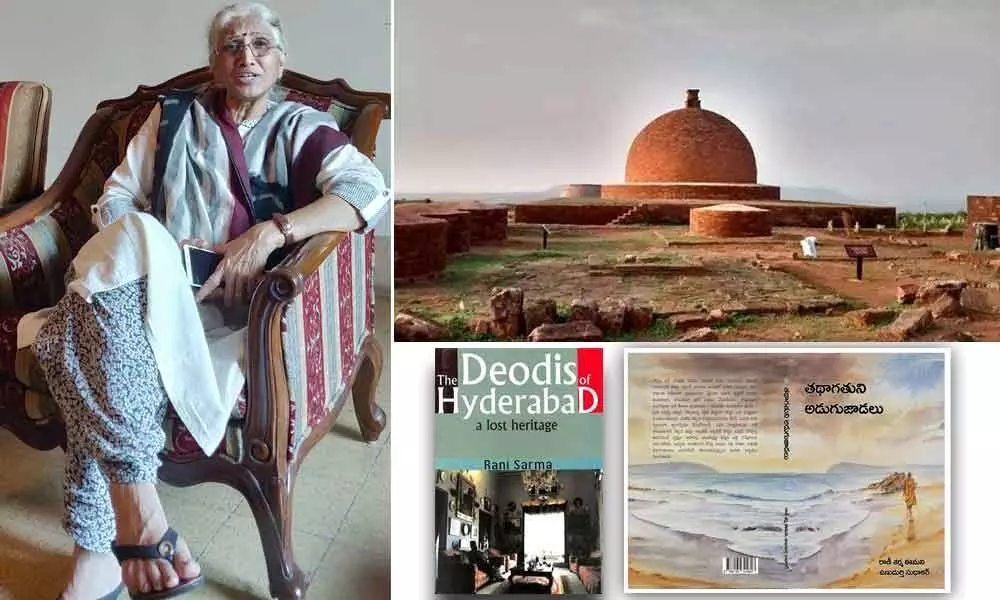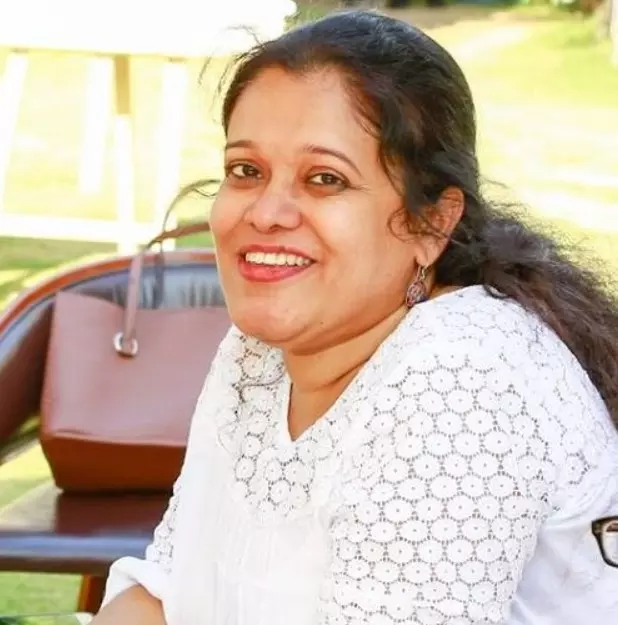Live
- Fake Congress session in the name of Gandhi: Bommai
- Women, youth leading charge in workforce participation in India in 2024: Report
- ‘Varthur Prakash attempted to honeytrap BJP leader using Shwetha Gowda’
- Garena Free Fire Max Redeem Codes (December 27, 2024): Unlock Skins, Bundles & Rewards
- Amid her battle with breast cancer, Hina Khan makes a comeback with ‘Grihalaxmi’
- How diet plays an important role in women’s gut health
- Poonch accident victim: Citizens offer condolences to Anoop Poojari
- Erigaise looking to qualify for next Candidates through World Rapid & Blitz
- Davanagere: Tackling garbage crisis through education
- CWC meet to discuss political developments in the country
Just In

Visakhapatnam-based historian and author Rani Sarma’s latest Telugu book, ‘Thathagatuni Adugujadalu (Vanishing Footsteps of the Buddha), is a personal journey of the author into the telltale remains of the Buddhist faith that had deep roots for about a thousand years in north coastal Andhra, which was a part of the ancient Kalinga Janapada…
Rani Sarma was born in Visakhapatnam, but her father, a medical doctor in government service led her to many places. Soon after her marriage to the bureaucrat EAS Sarma, she went to New Delhi, where she stayed for around 25 years before her husband decided he had enough of the government service and quit at the height of his career as the Secretary to the Government of India.
Later, he was posted at ASCI, the Administrative Staff College of India, which was originally a 'Deodi' – one of the majestic homes built amidst sprawling gardens by the nobles of Hyderabad under Nizam's regime.
"It is such a wonderful place to live in. I was using the same bedroom as Durru Shehvar, the daughter-in-law of Nizam Osman Ali Khan stayed," she shares. And adds, "We had been coming to Hyderabad every few months and each time I saw the city changing.
What I saw a starry-eyed young bride, the wide roads and such fine building were fast vanishing. The 'tehzeeb' and the essence of Hyderabad were missing.
History of Hyderabad is not just about the Nizams. There were several nobles, Maharaja Kishan Pershad, Shyam Raj Bahadur, Salarjung, et al, taking care of the administration.
When the feudal system demolished, some of the owners demolished their own buildings that were standing on huge tracts of land. The Urban Land Ceiling Act forced many to do away with their property and most beautiful buildings were gone."
It was during her stay at ASCI, she wrote the book, 'Deodis of Hyderabad' after much research.
Rani Sarma was always oriented towards heritage and when she came to Hyderabad, she found herself in thick of issues. She was the part of the core team that fought against the widening of the roads near Charminar, filed a case when Monsieur Raymond's Tomb was demolished by land sharks – they won the case and the court ordered the involved people to rebuild it and the petitioners had to approve of the new structure.
She states: "Heritage is a non-renewable resource. Once it is gone, you cannot get it back. You are just a custodian of heritage. You cannot play loose and fast with it. It belongs to the future. It belongs to the people."
When Rani Sarma went back to live in Visakhapatnam where EAS Sarma has gotten busy with his many official, and social commitments; she began exploring the region's heritage. "I found that in Vizag, INTACH was holding on to small matters and leaving the bigger picture behind."
Rani Sarma visited the ancient Buddhist site of Thotla konda when it was freshly excavated under the aegis of Dr Krishna Sastry. There were two other sites that were being excavated at the time - Bavi Konda, Pavurala Konda, the then director in Department of Archeology, Andhra Pradesh.
"When an ancient site is excavated, and is exposed it tends to collapse, and parts of it degenerate with vagaries of weather. We must conserve and protect it and make sure it survives. What you can't do is repair, rebuild or renovate heritage structures; it is blasphemy to even use the words.
When I first saw the site, the feeling was thrilling. It was almost like the Buddhist monks, who lived in the monastery for 600 years just abandoned it yesterday. We could see the column, the flooring, the lime plastering, the brick structure was original. And, that kind of thrill must be preserved."
She reveals, "In the recent years, in this excitement of promoting tourism, the archaeological sites were subordinated to Tourism, which changed the face of this invaluable heritage."
So, what is the state of Thotlakonda? "It is a sad spectacle," she says. "There is a brilliant framework of law in the country to protect ancient architecture. And, the State has violated every conservation law on the land in the name of tourism.
Within striking distance of the site, they built all kinds of structure. A 2,300-year-old footpath connecting the monastery to a bathing site was destroyed to build a 60-feet road. The entire character of the site has been changed by building pavements, meditation centres in the prohibited area.
The worst thing of all is that they rebuilt Thotlakonda. Today, you will not see the ancient bricks and walls, you will see a spanking new structure built three years ago. There is nothing left to salvage." Rani Sarma had not left any stone unturned to save Thotlakonda.
She met every official involved in the project. She wrote hundreds of letters to chief ministers, prime ministers, et al. "I wrote to Narendra Modi. I even wrote to Dalai Lama without expecting much of course.
There was an ASI representative, who came and visited the site and agreed that it was being destroyed. He said if the site was given to them, they could salvage it. But the State government was not ready to do so. I was distressed. In my anguish, I said I must at least leave behind a record of the ancient structure that was demolished for short term gains."
Rani Sarma's book 'Thathagatuni Adugujadalu' is not just about the ancient Buddhist sites in the region. It also explains the Buddhist way of living, explains what 'Sanghas' mean, the origins and spread of the faith that has influenced the entire world, West, East and even the Muslim countries where he is known as a Bilawar, the Budasaf.
I do not think that besides a sprinkling of officials in the government, anyone even understands the importance. Do they even know what must have happened within those brick walls? I even had an official tell me that these ancient sites will fail to interest the common tourists.
In which case, I told him they could build an interpretation centre with a replica and presentation on the history of the site. About 535 million people the world over follow Buddhism, and in the land where it's born, we fail to understand its prominence," she laments.
"I want the locals to read the book and take pride in their heritage. That is the reason to write the book in Telugu and thanks to Gita Ramaswamy of Hyderabad Book Trust, the book is priced at a very low cost," she adds.
'Thathagatuni Adugujadalu'
♦ Describes the discovery of the very significant archaeological sites of Visakhapatnam that compel the recasting of the city's history. The extensive triangular trade that the region participated in with Suvarna Bhumi (South Burma), Sri Lanka and the Mediterranean coast is described to place Visakhapatnam's historicity in the context.
♦ Thotlakonda is one of the three ancient Buddhist sites discovered near Visakhapatnam. Thotlakonda is taken as a prototype and the entire narrative of the book is woven around it. The narrative discusses Buddhist archaeology in India.
♦ The chapter on the Sangha outlines the biography of Buddha, traces the evolution of the sangha and provides glimpses of the life of the bhikkus and the bhikkunis of the sangha, bringing alive the piles of bricks and mortar that ancient monasteries like Thotlakonda represent. The narrative is illustrated with lively and not-so-often-written-about anecdotes from the Jataka Tales and from the scriptures.
♦ The ancient monastery of Thotlakonda is compared to those other early monasteries like Jetavana and Pubbarama as well as those of Sri Lanka of the Ashokan times.
♦ Interestingly, the local people continue to follow some of the Buddhist traditions despite the hundreds of years since the religion left India's shores. Both the people and the places continue to celebrate the Buddha, bearing his name and following the old Buddhist customs. Significantly, unlike elsewhere, where kings and merchant-princes supported Buddhism, in north coastal Andhra it was the humble people themselves who built, maintained and sustained the monastic complexes. Trade apparently brought men prosperity, a part of which was invested in religious settlements. There was a symbiotic relationship between the traders and the Buddhist monks. The local people looked to Buddhist monks for spiritual support and the monks drew sustenance from people for their economic needs.
♦ Many Buddhist sites have been identified in North Coastal Andhra. Where are the sites located, in what state do they survive? How many such sites have survived and how many have vanished? What factors are at force to cause the disappearance of the archaeological sites?

© 2024 Hyderabad Media House Limited/The Hans India. All rights reserved. Powered by hocalwire.com







